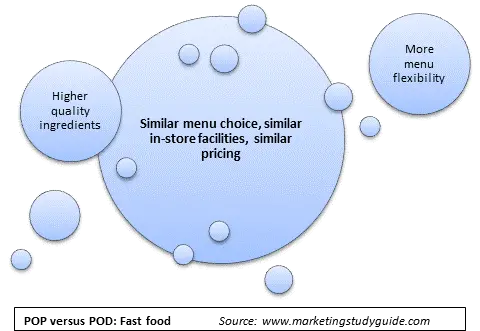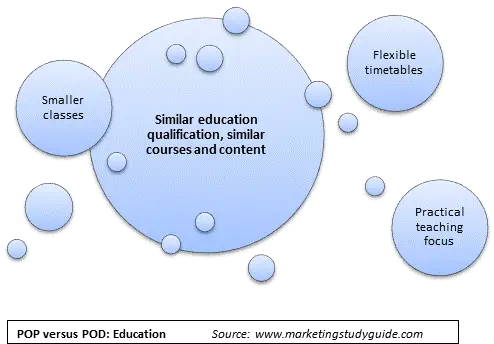Effective positioning leverages a combination of familiarity and uniqueness. POPs ensure the product aligns with established norms and expectations, while PODs drive engagement through innovation, niche targeting, price differentiation, shared values, and experiential appeal. Brands that balance these elements create a strong foundation for competitive differentiation while addressing both practical and emotional consumer needs. This dual strategy fosters both credibility and preference, essential for winning market share.
Contents
- Points-of-difference (POD) and points-of-parity (POP) examples
- Example 1 = McDonalds
- Example 2 = Education
- NOTE: Key Themes in Points-of-Parity (POP) and Points-of-Difference (POD) Examples
- 1. Establishing Credibility Through POP
- 2. Differentiation Through Innovation and Personalization
- 3. Addressing Niche or Underserved Markets
- 4. Competitive Pricing as a POD
- 5. Emphasizing Values and Experiences
- 6. Leveraging Existing Brand Weaknesses
Points-of-difference (POD) and points-of-parity (POP) examples
To see how POD and POP work in real life, let’s look at some examples. These examples demonstrate how businesses use a balance of POP and POD to position themselves effectively in competitive markets. Each example highlights the importance of blending familiarity (POP) with innovation (POD) to meet market needs and capture consumer interest.
Example 1 = McDonalds
The first example looks at a possible way that a chain of fast food outlets could challenge the market leader (in this case let’s assume that the market leader is McDonald’s). The center circle in the diagram below highlights the points-of-parity that the rival chain wants to duplicate (which includes a similar menu choice, similar in-store dining facilities, and pricing around the same level).
However, the rival firm chain still needs to give consumers a reason to switch, so they have identified two points-of-difference to highlight as part of their overall positioning (which are built around high-quality ingredients and having more flexibility in the menu for the individual). The overall combination of POP and POD creates their overall positioning.
Example 2 = Education
The second example in the next diagram focuses upon a small education provider, who offers an alternative to a large university program. Again the large central circle highlights the points-of-parity (by highlighting that the qualifications and courses are similar). The points-of-difference (as highlighted in the outside circles) indicate that this particular college/school has decided to emphasize three major differentiating benefits.
With these examples, you can see how the overall positioning is created using a balanced mix of points-of-parity (to piggyback on a market leader) and points-of-difference (to give consumers a clear reason to use their product/service).
Example 3 = Budget Airline vs. Full-Service Carrier
A budget airline challenges a full-service carrier by adopting points-of-parity like flight safety standards and on-time reliability. To stand out, it highlights its lower ticket prices, a no-frills approach, and an easy-to-use online booking system that simplifies the process for cost-conscious travelers. By focusing on value and efficiency, the budget airline appeals to travelers prioritizing affordability and convenience.
Example 4 = Local Coffee Shop vs. Global Chain (e.g., Starbucks)
A local coffee shop competes with Starbucks by ensuring points-of-parity such as a similar menu with a variety of coffee and tea options, comfortable seating, and free Wi-Fi. To differentiate, it emphasizes PODs like using locally sourced beans, offering unique community-based events, and creating an intimate, welcoming atmosphere. These differentiators attract customers who value supporting local businesses and seeking unique experiences.
Example 5 = Fitness App vs. Leading Gym Chains
A fitness app competes with traditional gyms by offering points-of-parity such as structured workout plans, progress tracking, and professional trainer-led sessions (albeit virtually). Its PODs include 24/7 accessibility, affordability with subscription pricing, and gamified challenges to keep users engaged. These differences make the app attractive to users seeking flexibility, convenience, and cost savings compared to gym memberships.
Example 6 = Electric Car Start-Up vs. Tesla
A new electric car start-up competes with Tesla by ensuring POPs like a long driving range, access to charging networks, and advanced autonomous driving features. The PODs focus on unique offerings such as a significantly lower price point, a fully customizable interior, and enhanced integration with renewable home energy systems. These PODs target cost-conscious eco-friendly consumers seeking personalization and energy efficiency.
Example 7 = Online Learning Platform vs. Coursera
An emerging online learning platform competes with Coursera by replicating POPs such as accredited courses, a wide variety of subjects, and partnerships with leading universities. To differentiate, the platform emphasizes PODs like live, interactive classes, affordable subscription pricing, and a career coaching feature that pairs graduates with personalized job placement services. These PODs appeal to students seeking both affordability and practical career outcomes.
Example 8 = Local Organic Grocer vs. Whole Foods
A local organic grocer competes with Whole Foods by matching POPs such as certified organic products, high-quality fresh produce, and an inviting in-store atmosphere. The PODs include direct partnerships with nearby farms, offering unique, seasonal products not available at larger retailers, and providing a delivery service with zero-waste packaging. These differentiators attract environmentally conscious consumers who prioritize supporting local communities.
Example 9 = Wearable Fitness Device vs. Fitbit
A new wearable fitness device enters the market by replicating POPs such as step tracking, heart rate monitoring, and smartphone compatibility. To stand out, the device introduces PODs like hydration tracking, personalized injury prevention advice based on movement analysis, and a built-in meditation coach with real-time stress level feedback. These unique features cater to health enthusiasts seeking an all-in-one wellness solution.
Example 10 = Streaming Service vs. Netflix
A new streaming service challenges Netflix by ensuring POPs like a vast library of movies and TV shows, personalized recommendations, and high-definition streaming. Its PODs include niche content focusing on independent and foreign films, exclusive collaborations with emerging filmmakers, and a lower subscription fee with ad-supported options. These differentiators attract cinephiles and budget-conscious viewers looking for unique, underrepresented content.
NOTE: Key Themes in Points-of-Parity (POP) and Points-of-Difference (POD) Examples
The examples provided across various industries reveal key themes in how Points-of-Parity (POP) and Points-of-Difference (POD) are leveraged effectively to position brands in competitive markets. By balancing familiarity with differentiation, businesses can appeal to consumer expectations while offering compelling reasons to switch or engage. Below, we explore recurring themes and why they tend to work.
1. Establishing Credibility Through POP
In every example, POPs play a foundational role in reassuring consumers that the brand meets industry standards or aligns with their expectations. For instance:
- Electric Cars: The new start-up ensures POPs like long range and access to charging networks, making it comparable to Tesla.
- Streaming Services: By offering personalized recommendations and a vast library, the new service aligns with consumer expectations set by Netflix.
Why It Works
POPs build trust. They signal to consumers that the product or service offers what they already value in established competitors. Without adequate POPs, a brand may appear as an inadequate substitute, reducing the likelihood of trial or consideration.
2. Differentiation Through Innovation and Personalization
PODs often highlight unique features, innovative solutions, or personalization to stand out:
- Wearable Fitness Device: The introduction of hydration tracking and stress-level feedback goes beyond standard tracking features.
- Online Learning Platforms: Career coaching and live classes add a human-centric and results-oriented appeal.
Why It Works
Consumers value innovation when it addresses unmet needs or solves problems. Differentiation through features that enhance convenience, relevance, or experience helps a brand stand out and attract niche segments within the market.
3. Addressing Niche or Underserved Markets
Several examples focus on capturing market niches that larger competitors may overlook:
- Local Organic Grocer: By focusing on direct partnerships with local farms and zero-waste delivery, it caters to environmentally conscious shoppers.
- Streaming Service: Highlighting independent and foreign films creates appeal for cinephiles often underserved by mainstream platforms.
Why It Works
Focusing on niches allows brands to connect deeply with specific customer segments. When larger competitors aim for broader appeal, new entrants can succeed by catering to more specialized preferences.
4. Competitive Pricing as a POD
Several examples use affordability or value as a differentiator:
- Electric Cars: The start-up emphasizes significantly lower pricing compared to Tesla.
- Streaming Services: The ad-supported, lower subscription fee targets budget-conscious consumers.
Why It Works
Price sensitivity remains a universal consumer consideration. Providing a cost-effective alternative while maintaining quality ensures appeal to price-conscious buyers, especially in highly competitive markets.
5. Emphasizing Values and Experiences
Examples also highlight themes of shared values and customer-centric experiences:
- Local Coffee Shop: Its focus on supporting local businesses and creating a community atmosphere resonates with customers who value connection.
- Fitness Devices: Features like meditation coaching align with broader wellness goals, enhancing the emotional connection with users.
Why It Works
Modern consumers increasingly value emotional and experiential connections with brands. Aligning with their personal values or offering enriched experiences fosters loyalty and advocacy.
6. Leveraging Existing Brand Weaknesses
Some PODs directly address perceived gaps in established competitors:
- Mother Energy Drink (Coca-Cola): The relaunch strategy directly countered criticism of the original product’s taste.
- Local Grocer vs. Whole Foods: Zero-waste packaging and local sourcing tackle criticisms about corporate chains’ environmental impact.
Why It Works
When brands can address the shortcomings of market leaders, they position themselves as solutions to consumer frustrations, creating a compelling case for switching.


